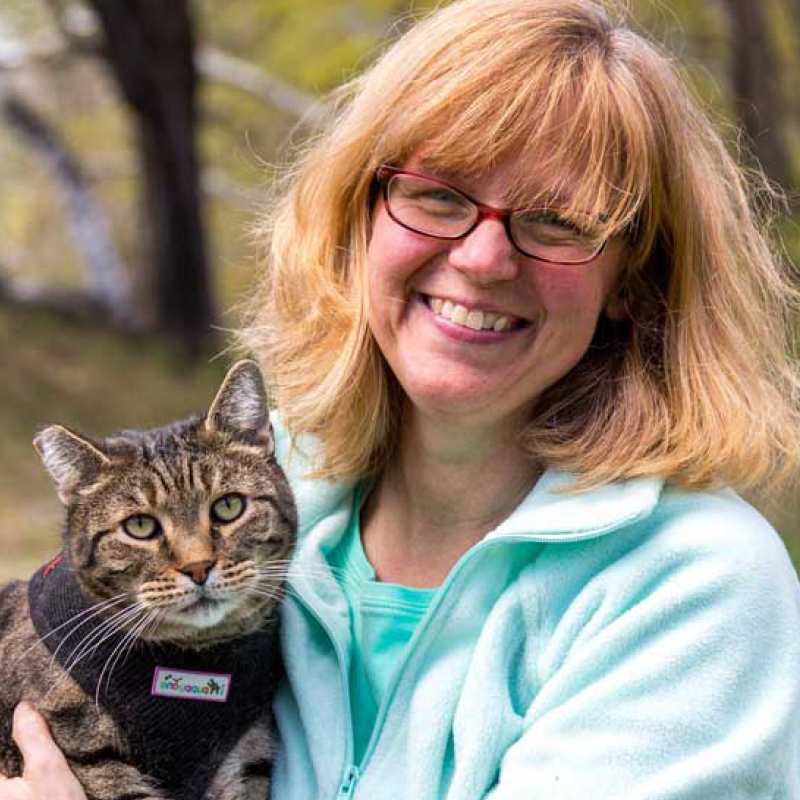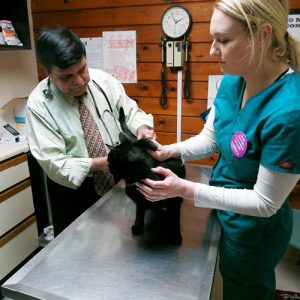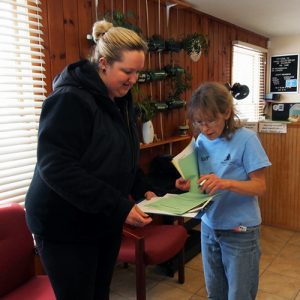
Interview! Ask Stacy! Online Cat Conference Review
March 31, 2018
Interview! Vickie Fisher – President of The International Cat Association (TICA)
April 7, 2018

This week’s post comes to you from guest blogger Liz Pease. If you’d like to know a little more about Liz and her experience in non-profit management, TNR and cat care, check out episode 51 of the podcast.
One of the best ways to get to know your community—and get in touch with folks who need help with spay/neuter and other resources—is to run a low-cost vaccine and microchip clinic. These clinics are always tremendously appreciated by low-income pet owners, as well as pet owners on a budget, and with a little planning, they can be incredibly successful—and can even be utilized as fundraisers!
If you think your group is too small or too new to run a clinic on your own, talk with local vets or with other groups—they might just be willing to collaborate on a clinic with you!
In my time at the Merrimack River Feline Rescue Society, I ran many vaccination/microchip clinics, and have figured out some best practices (and things not to do!) over the years. Here are key things to keep in mind as you plan:
- date/time— A good place to start is by finding out local dog licensing deadlines in your area and planning a clinic shortly before that date. People tend to wait till the last minute to get their dogs up to date on vaccines, so you’ll be sure to attract a lot of attendees that way! As far as day of the week goes, your best bet for attracting as many people as possible is going to be a weekend day. Just keep in mind that many veterinarians work on Saturdays, so a Sunday may be easier for them. Keep the clinic to no more than two or three hours to increase your chances of finding volunteers. We have also found that spring clinics tend to be more popular than fall clinics.
- location— In my experience, an large indoor location like a gymnasium, senior center, dog training room in a shelter, or cafeteria—ideally with a small room (or even a pop-up tent) off to the side for cats— works best, but outdoor clinics can be successful too, especially if you use a pop-up tent with sides as a cat area. Extra bonuses in a location include: two entrances so that dogs and cats can be in separate lines to reduce stress on cats; a double-door entrance to reduce chance of escapes; room for people to wait indoors outside of hot, cold, or wet weather.
 vets and volunteers— The first volunteer you need to secure is your veterinarian(s). (Ideal is to find two vets – one for cats, one for dogs!) Plan your clinic around your vet’s schedule! If you are having a hard time finding veterinarians, reach out to your own vet, or connect up with a local shelter or spay/neuter clinic in your area. Who knows—they might even want to partner with you on a clinic or hold it at their location! Once you have your vet in place, the next key role is vet techs or shelter staff who are experienced at animal restraint, vaccine administration, and microchip insertion. Once you have vets and techs in place, start to fill in your other volunteers. Here’s a volunteer matrix for a clinic that has separate “stations” for cats and dogs, and generally sees at least 100 animals.
vets and volunteers— The first volunteer you need to secure is your veterinarian(s). (Ideal is to find two vets – one for cats, one for dogs!) Plan your clinic around your vet’s schedule! If you are having a hard time finding veterinarians, reach out to your own vet, or connect up with a local shelter or spay/neuter clinic in your area. Who knows—they might even want to partner with you on a clinic or hold it at their location! Once you have your vet in place, the next key role is vet techs or shelter staff who are experienced at animal restraint, vaccine administration, and microchip insertion. Once you have vets and techs in place, start to fill in your other volunteers. Here’s a volunteer matrix for a clinic that has separate “stations” for cats and dogs, and generally sees at least 100 animals.- supplies— If you operate a shelter, getting the medical supplies will be easy for you, but if not, you’re going to need to rely on your volunteer veterinarian to purchase the vaccines and microchips for you. Vaccines aren’t the only supplies, needed, however. For the clinics I used to run, I set up boxes with “shopping lists” for registration tables and for clinical tables. It’s the only way to make sure you don’t forget the paper towels you’re going to need when the dogs start to pee on the floor! For future clinics, you can consider adding in sales of things like flea preventatives, extra vaccines, and even combo and 4DX tests—but start simple until you get your feet under you!
- pricing— Some of this will have to do with how much your vaccines and microchips cost, of course, but the bottom line is, go as low as you can! When we did $5 rabies vaccines, the volume at our clinics was huge. When we went up to $10, volume dropped way off. We have always offered chips at $15, which is a bit pricey for many people, but was as low as we could reasonably go. If you are part of a nonprofit, to help defray your costs, see if you are eligible for shelter pricing through Zoetis, Boehringer Ingelheim, or Merck. Check out grant and sponsorship opportunities with local banks and other companies/organizations too—having a banner with their name and logo on it as a sponsor of your clinic may be a great perk that a company will be glad to contribute for! Organizations like Bissell Partners for Pets are often interested in helping with funding microchip clinics also. If you have accounts set up with vaccine or microchip providers, ask if they would be willing to donate any product to the event. It never hurts to ask!
 marketing— The number one key to a successful vaccine/microchip clinic is getting the word out! I have found that social media is a NOT a good way to spread the word about these clinics. This is one of those times when good old-fashioned flyers posted in places like grocery stores, laundromats, post offices, libraries, etc. are your best bet. (Check out sample sample flyers 1 and 2) It’s also worth reaching out to local animal control officers and town clerks to let them know about the clinic and invite them to participate. Those folks often handle the dog licensing and will be glad to know of this resource (and they might be willing to set up a table to help clinic attendees register their dogs on site!). Check to see if your city or state keeps a list of rabies clinics. The Department of Agriculture here in Massachusetts keeps a state-wide list of rabies clinics on their website, for instance, that you can add your clinic to using an online form. You can also consider a press release to your local papers to spread the word. Here’s a sample you can use.
marketing— The number one key to a successful vaccine/microchip clinic is getting the word out! I have found that social media is a NOT a good way to spread the word about these clinics. This is one of those times when good old-fashioned flyers posted in places like grocery stores, laundromats, post offices, libraries, etc. are your best bet. (Check out sample sample flyers 1 and 2) It’s also worth reaching out to local animal control officers and town clerks to let them know about the clinic and invite them to participate. Those folks often handle the dog licensing and will be glad to know of this resource (and they might be willing to set up a table to help clinic attendees register their dogs on site!). Check to see if your city or state keeps a list of rabies clinics. The Department of Agriculture here in Massachusetts keeps a state-wide list of rabies clinics on their website, for instance, that you can add your clinic to using an online form. You can also consider a press release to your local papers to spread the word. Here’s a sample you can use.- record keeping — You’ll want to think ahead to where you will store all of the rabies certificates and microchip forms (after the registrations are sent in). If you are working with a clinic or shelter, they may be willing to file the records for you, but if not, you’ll need to keep these records filed according to the medical data retention policies of your state. Also make sure to put some kind of contact information on the rabies certificates the clients take home in case they ever need to get in touch about their records.
- collecting & sharing information— Finally, don’t forget that a vaccination/microchipping clinic is a great place to collect email address of folks interested in your programming, and a great place to get the word out about other programs and events your group offers. You can even collect specific information from attendees around issues important to your group (like whether they are feeding community cats, whether they are interested in becoming involved with your group, etc.) Make sure to bring along plenty of materials to share with attendees!
Once you have your plan in place, here are a couple of other things to consider and make sure you are prepared for:
- handling cats —It is critical to make sure you have a skilled cat handler at this event. While these clinics are for pet cats, not ferals, we all know that unhappy pet cats can be incredibly difficult to handle, and that poor handling can result in bites, scratches, or even an animal running off. To avoid this, be sure the person filling the tech role is experienced with cats of all kinds, and that you have towels, bite gloves, and possibly a net handy.
- dealing with unaltered animals —You are sure to have unspayed/neutered cats and dogs come through the clinic. Make sure you have flyers and information available on local spay/neuter programs. Even better, have representatives from those programs on hand to sign people up on the spot!
Good luck and happy planning!

Liz Pease is the former Executive Director of the Merrimack River Feline Rescue Society. She has been involved in animal welfare since 2004, when she TNRed her first feral cats. Liz is now a freelance writer and editor.




